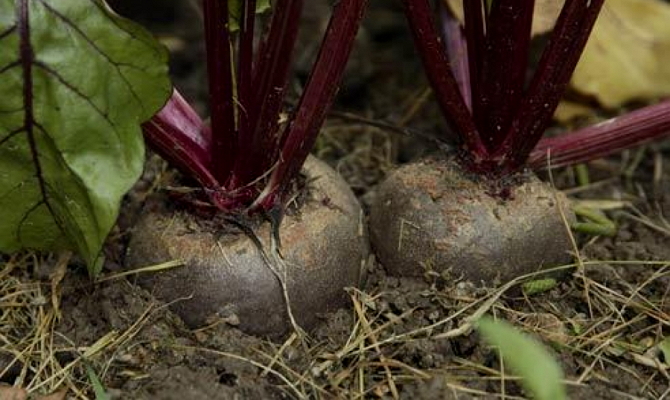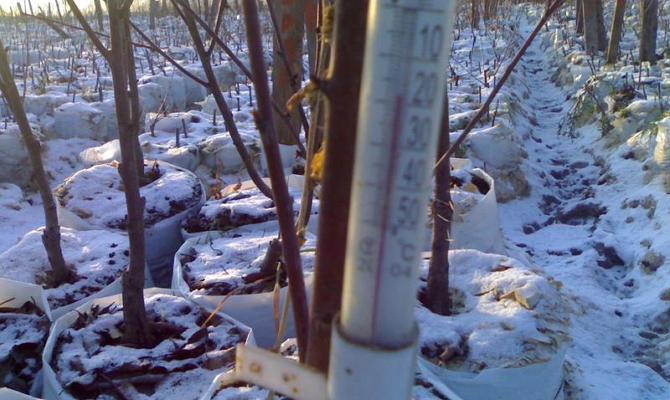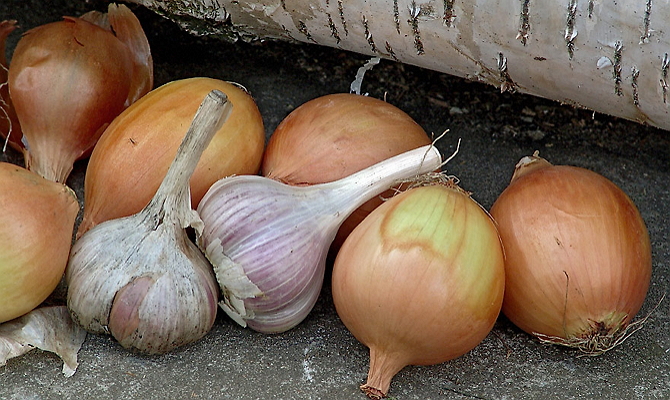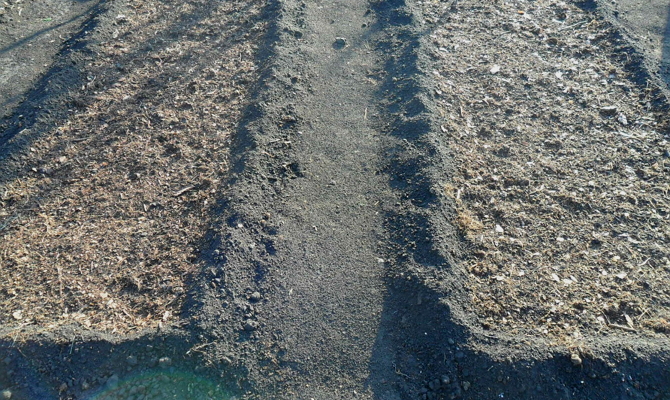Some plants gardeners are planted not in spring, but in autumn. This allows them, firstly, to get a crop a couple of weeks earlier than usual, and secondly, to save precious time in the spring when there is a lot of work in the garden. So, find out what vegetables and what greens can be sown in your garden for the winter.
What can I sow during the winter?
The list of garden plants, most often planted in autumn, is as follows:
- Garlic It is necessary to plant until the earth freezes. If you do this before, it can start to grow, and when frost comes, it will die. This bulbous plant requires a cold period of development, and to prevent frosting beds with garlic should be covered with straw.
- When the earth freezes to a depth of 5 cm (usually November), they plant beets. To do this, choose cold-resistant varieties: "Podzimnaya", "Cold-resistant 19", "Detroit round". Such beets will withstand winter frosts well and will not be fired.
- Sow carrot for winter - also a great idea. Due to this you will get the first fruits in June, and by the autumn they will grow larger and sweeter than with traditional spring sowing.
- Under winter, as practice shows, you can sow absolutely any greens: dill and parsley, lettuce and basil, celery and spinach. They will provide you with fresh greens in early spring. Pay special attention to the culture that has long risen.
- What else to plant under the winter in the garden? Of course, flowers!! Mixed planting is a popular way to protect your vegetables from pests. Under the winter you can plant mint and coriander, sage and, lovage and elecampane, echinacea and many others. other
Podzimnius sowing plays the role of natural stratification for most cultures. Their seeds are hardened, and then sprout to please you with luscious greens, useful vegetables or beautiful flowers.
It's getting colder ... Winter is about to announce its rights, and we're still trying to extend the garden season, making the last podzimnie crops. So what can you sow-plant under the winter, and is it worth it?
Pros and cons of sowing vegetables for the winter
The main advantage of sub-winter crops is the possibility of obtaining an early harvest. In the spring sometimes it takes a very long time to wait until the earth ripens and warms up (read about). At the same time, young shoots already appear on the sub-winter crops. And already in the middle of summer, the place, freed after collecting early products, can be used for obtaining a second crop.
Plants planted under the winter are more resistant to unfavorable weather conditions. After all, during several winter months, the seeds have already been quenched and stratified right in the ground. Such plants can form a very powerful root system, so they will need less watering.
However, there is a danger that during the thaw the seeds of vegetables sown for the winter can germinate and then die when frost sets in. Beets and carrots can "go to the arrow" and instead of good roots you will get only flower arrows and seeds. There is always a risk of losing crops, but you will still have the opportunity to correct everything in the spring.
Terms of planting vegetables for the winter
Concerning the timing of podzimnih crops, the opinions of truck farmers often diverge. Some advise to sow the seeds back in October, so they managed to get through before the winter cold. Others believe that it is necessary to sow 5-8 days before the onset of persistent frost, at a time when the air temperature is at the mark of + 1-3 ° C. I still hold the second opinion. The overwintered seeds can successfully germinate at the appointed time in the spring, and if they get premature, they will go to winter in a weakened state. In this case, it is better later than before.
You can sow the seeds on the already prepared beds also during the winter thaws in December-January, possibly even in the snow. But onion and garlic still need to be planted before the onset of cold days, so that bulbs can take root, but do not go into growth.
Features of the sub-winter planting
The yield of podzimnih crops depends very much on the correct compliance with agricultural technology. The soil for sowing should be prepared in advance, 2-3 weeks before sowing, so that the land can settle a little. During digging, it is advisable to make humus or compost, as well as 20-30 g of complex fertilizer (nitrofosca, etc.) and 1 cup of ash per 1 m 2.
The site should be carefully planned, trying not to allow slopes and irregularities, otherwise the seeds can be washed off with melt water, and all work will go wrong. It is advisable to make grooves in advance for sowing, then it will be possible to sow even in frozen soil. It is recommended to make grooves a little deeper than usual to add a little humus or compost.
Supporters believe that digging a site before sowing is not mandatory. If the place under the future beds is free of weeds, it's enough just to cut the grooves, lightly sprinkle them with a mixture of ash and humus and on this preparation for sowing can be considered complete.

The sown seeds are covered with earth, sand or a previously prepared soil mix (if sown in the frozen ground). Fill the grooves with ground a little bit smaller than in spring sowing. Above the bed is necessarily mulched with peat or compost to prevent the formation of a crust and retain moisture.
Seeds can not be soaked and treated with growth stimulants, as in spring planting. Our task is to prevent premature germination of seeds, so any additional manipulations will be superfluous.
In the early spring, when snow has not yet come down, it is desirable to cover the garden with a film or a black nonwoven material. With the onset of heat, the crops are once again fertilized, this time with a nitrogen fertilizer (urea) in the calculation of 15-20 g per 1 m 2.
Vegetable crops for sub-winter crops
Sometimes, especially in the southern regions, from last year's self-seeding sunflower, tomato, pepper, watermelon and melons grow full-fledged plants. But, as a rule, the yield from such plants turns out to be much lower than when planting in usual terms. Therefore, for sowing under winter, it is recommended to take only seeds of cold-resistant crops: parsley, dill, spinach, lettuce, sorrel, beets, carrots.
Parsley - one of the coldest, but its seeds slowly rise. Therefore, sowing parsley under winter has an undoubted advantage over spring sowing, because it allows you to get young greens a few weeks earlier.
Seeds dill well tolerate any frost. And dill always turns out better from self-sowing or planting in a spread than when planting in rows.
Spinach can be sown in autumn at any time. Outlets of young leaves are well tolerated by frosty frosts under light cover and a layer of snow.
Sowing beets under winter, gardener will help in those cases if the spring will be protracted and the sowing will be postponed to a later date, and also if there is too little precipitation in the spring.
The same can be said about carrots. But the seeds of carrots tugovsiny and in the spring they have to soak in order to get amicable shoots. When sowing for the winter, carrots undergo hardening and stratification in natural conditions. And when the temperature reaches the optimal level in the spring, the carrot rises fairly quickly and amicably.
Root seeds are best picked from those varieties that do not shoot: beets - Cold-resistant 19, Podzimnyaya A-474, One-rooted, Egyptian flat, carrots - Nantes 4, Moscow winter A-515, Vitamin, Losinoostrovskaya.
Bow-sowok, planted under the winter, well preserved in the ground and very rarely freezes. This bow does not shoot and will give a good harvest in the new season. The onions are larger, but the one that is intended for forcing greenery, is also suitable for autumn planting. Young green onion feathers will be among the very first vitamins on your table in early spring. You can also sow onions with seeds, choosing the most recent dates so that the seeds do not germinate.
In this topic, we can not fail to mention garlic, t. all winter varieties of garlic produce the greatest yield at the time of landing. About how, and, read a separate article on our website.
We wish you good harvests! Follow the updates of the site. Subscribe to new articles.
When the cold comes and the site covers the snow, no one will say that under it can hide the culture that is sometimes planted in the winter for a garden. Let's find out which planting material is suitable for this purpose.
1
Uninvited in gardening and truck farming townspeople, coming to the dacha, are often perplexed, seeing by the end of autumn neighbors in the plot, actively hoeing beds and sowing seeds. After all, just about frost will hit, and all the planting material will die. But no - it is known how large areas are sown with winter wheat, and in the late autumn they put onions and garlic. Many vegetables can be planted before the first snowfall or even during it into the prepared holes.
And you can not be afraid that the seeds will freeze, because there are certain rules for sowing, and snow will cover them from frost more than reliably.
Seeding for the winter season
What will give the sub-winter planting of fruit and bulbous crops, as well as greens? First of all, this is the hardening of plants, the weakest, no doubt, will perish, but this will be a small percentage of inevitable losses. But those that give seedlings in thaws will be much stronger than those planted in the spring. In addition, the fruits of such overwintered cultures will be much larger and better, because the shoots will appear much earlier than the awakening of all kinds of diseases and pests. And, of course, the 2 weeks that have been won are of no small importance, which would have to wait for sowing in the spring until the soil warms up completely. And the use of hotbeds in the beginning of melting snow will give a win in 2 weeks.
However, this type of sowing has significant drawbacks. In particular, the same thaws in the early spring can play a cruel joke with your vegetables and root crops. When after the snow falls the plants will rapidly grow, absorbing the moisture of thawed waters, frost may return, especially in the middle zone of Russia, and then the plantings will freeze. However, large losses can be avoided, using hotbeds, the advantages of which were discussed above. There is another danger - if the heat comes to replace the cold too sharply, the root crops can throw out the flower arrows instead of the tops, which instead of harvest will provide you with only seeds.
2
So, now you know that the landing podzimnie not only possible, but also have some advantages (for all their shortcomings) before the spring. It remains only to find out what can be planted on a country plot for winter in the garden and in the garden. Pro and garlic is known to many, but still we will repeat, these are the most stable crops for autumn planting in front of the cold. In particular, garlic ejects arrows the very first, as soon as the soil begins to warm up in spring, sometimes outstripping the grass.
And in March you will be provided with the first vitamins from the garden. Onion also perfectly tolerates winter, especially if planted with seeds before the coldest. Stable plants include sorrel, spices (oregano, mint, melissa). As for other frost-resistant vegetables, among others, beet, notably its winter-hardy varieties for the middle belt and more northern latitudes, is not the last. The same can be said about carrots, which in the spring can not rush to throw out sprouts. But after the winter forced stratification, when the seeds are hardened by cold, the most viable will give friendly shoots already when the soil is warmed to the required level (when it is time to start spring sowing).

Frost-resistant beet variety
And, of course, do not forget about the radish, because it is also planted with seeds, which in some varieties are perfectly tolerated by the cold. These are all medium-stable cultures. By the way, if you decided on the arrows, you can increase the number of sources of vitamins and plant a variety of greenery. In spring, it shoots almost at the same time as the grass, so the beds should be prepared very carefully. Now let's find out which is better to plant from the greens in the winter in the garden. First of all, it is fennel and spinach, as well as celery.
You can also sow salads, both head and leaf. And, of course, different varieties of cabbage, mostly red and Beijing, as well as color. If you like to grow something that is not atypical for the garden, sift the rukkola, parsnip and cucumber grass.
3
The garden at the dacha, as a rule, is not a separate plot, here in a small area very often garden beds and berry crops are adjacent to the beds. Many people know that trees can be planted in the winter, so we will not touch them. Let's talk more about other garden plants, which can be attributed to risky or unstable plantings. In particular, it is corn and sunflower, which are closer to the heat-loving, and therefore the early shoots can be beaten by the returned frosts. From vegetable to risky tomatoes and potatoes are included.

Planting trees in the winter
If plants with low spring germination stability after sub-winter planting give an insignificant percentage of germination, the next year such an attempt can yield a very large yield. The main thing is to regularly resort to this type of planting and experiment with shelter and mulching. As for the berry, they all belong to the medium-stable, so they need shelter when planting in the winter.
However, to a more or less stable cultures can be attributed red currant (although it must be planted earlier than others), but the black is much less tolerable recurrent frosts in the spring, so working with it is more risky. Among the plants that are planted in the garden for the winter, you can list such crops as raspberries and gooseberries (in October), and sometimes in the garden in the early autumn (no later than September) strawberries are planted. The main thing is that before the cold weather the berry-growers manage to form the root system, then they will be able to winter, next season they will shoot, and in a year they will begin to bear fruit.
4
Since onions and garlic are among the most stable winter plants, we will not mention them. As for the risk group, the varieties and hybrids of the cultures entering into it should be selected individually, based on the geographical latitude on which your site is located and the overall climatic indexes. Therefore, let's talk about the medium-stable plants that can sow beds.

Winter onions and garlic
First of all, it is beetroot, it is best to choose frost-resistant varieties, such as Podzimnyaya A-474 and Cold-resistant 19. It is very good for growing with wintering even in latitudes close to the north, Polar flat K-249. It withstands rather strong frosts and flat Egyptian. All these varieties combine such qualities as winter hardiness and resistance to the appearance of peduncles.
Carrots are also not suitable for any, it is best to choose such varieties as Nantes 4 and Vitamin 6. First, they tolerate the winter well, and secondly, they are very tasty and have a very juicy structure. It is also recommended to plant suitable for northern regions variety NIIOKh 336. All of them are quite resistant to the release of flowering shoots in the spring. For radish is more important another quality - the development of plants in conditions of insufficient illumination, they have the following grades: Heat, Dawn and Rose-Red with a white tip.
5
It is very important to accurately determine the time for sowing a particular crop so that the above-ground part does not actively develop in the last warm days of the season, which will necessarily freeze with the onset of cold weather. Ideally, when preparing a garden for winter, you need to focus on numbers when the average daily temperature is 0. But it is still possible to return heat, so it's better to hedge and wait for the first frost to grab the ground.

Preparing the garden for winter
Usually such a moment is accompanied by a sharp temperature drop, that is, from +3 to -5. If the beds are prepared in advance, and the holes are waiting for the seeds to fall in, they can be planted. In any case, it is recommended not to start planting before October, when it comes to seed crops. The fact is that prolonged warming of the soil even in autumn can induce sprouts to germinate, and then they will necessarily freeze already at the first sub-zero temperature in the soil.
And even if such awakened seeds do not die, they will be weakened by the struggle with the cold. While the planting material, which has preserved the whole shell throughout the winter, will get a good hardening by stratification, as already mentioned. Therefore, wait for the first frost - the messenger of stable cold weather, which will come in a few days, and urgently start sowing.
6 How to properly prepare the land for winter planting?
In addition to choosing the timing, you need to know some features of the sub-winter planting, that is, to be able to create optimal conditions for the seeds in the soil. And the first thing to do is to ensure that the planting material does not freeze, that is, to exclude cold air into the ground. Therefore, the land should be loosened not less than 2 weeks before planting, then the clods will have time to settle slightly, but they will not prevent access to moisture at the end of winter, when the heated snow mass turns into thawed waters.
The optimal solution is to cover the rows with a film so that the seeds do not get into the soil, and also that the rains do not blur the grooves or wells made beforehand. Furrows depth of about 5 centimeters are made long before sowing only if you are going to put the seeds in the soil during its freezing. You need to take care not only of the condition of the soil, but also of what you will shower and cover your crops.
For this purpose, prepare in advance a dry friable soil, mixed with sand and mineral fertilizers. For mulch, compost or peat will be needed, they will protect the planting from cold, if the snow layer is too thin, and at the same time keep the optimum moisture level in the depths of the beds. Seeds before planting them in the ground, do not need to soak or even moisturize, they should not germinate until the spring. Therefore, evenly distribute them in the grooves (2 times more than in the spring planting), on top of the sifting dry soil and cover the row with 3 centimeters of mulch. From above it is recommended to put lapnik or dry leaves with a thickness of about 20 centimeters.
